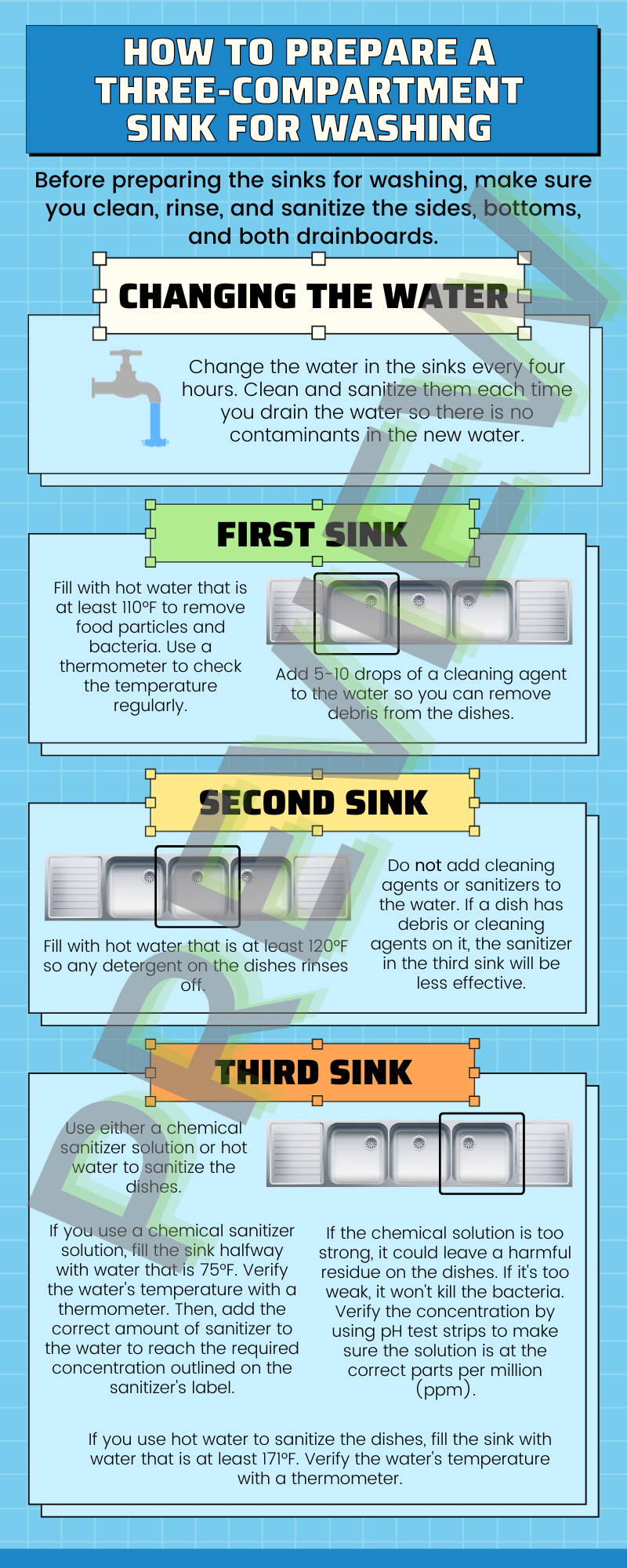Three-Compartment Sinks
Languages: English
Media Editing: The video module(s) in this subject are editable under our Content Studio offering unless otherwise indicated. For more information about Content Studio, contact your CSM.
Description: In a commercial food environment, either in the Grocery or Restaurant industry, keeping your facility sanitized is extremely important to prevent foodborne illnesses and the spread of bacteria. In this subject, learners are taught how to properly prepare and use a three-compartment sink to make sure that all dishes, utensils, and equipment are sanitized and free of harmful pathogens. This includes knowing what each sink is for, the required water temperatures, how to clean and sanitize the dishes, as well as other vital techniques.
Languages: English
Media Editing: The video module(s) in this subject are editable under our Content Studio offering unless otherwise indicated. For more information about Content Studio, contact your CSM.
Description: In a commercial food environment, either in the Grocery or Restaurant industry, keeping your facility sanitized is extremely important to prevent foodborne illnesses and the spread of bacteria. In this subject, learners are taught how to properly prepare and use a three-compartment sink to make sure that all dishes, utensils, and equipment are sanitized and free of harmful pathogens. This includes knowing what each sink is for, the required water temperatures, how to clean and sanitize the dishes, as well as other vital techniques.
Languages: English
Media Editing: The video module(s) in this subject are editable under our Content Studio offering unless otherwise indicated. For more information about Content Studio, contact your CSM.
Description: In a commercial food environment, either in the Grocery or Restaurant industry, keeping your facility sanitized is extremely important to prevent foodborne illnesses and the spread of bacteria. In this subject, learners are taught how to properly prepare and use a three-compartment sink to make sure that all dishes, utensils, and equipment are sanitized and free of harmful pathogens. This includes knowing what each sink is for, the required water temperatures, how to clean and sanitize the dishes, as well as other vital techniques.
Topics
Three-Compartment Sinks: Overview/General Information
-
Three-component sinks are used as an alternative to commercial dishwashers to both clean and sanitize dishes, utensils, and equipment, in order to kill harmful bacteria and prevent the spread of foodborne illnesses. In this topic, learners are taught the components of a three-compartment sink, the difference between cleaning and sanitizing, and how to use/store equipment needed to use a three-compartment sink.
-
Questions (level 1, 2, 3)
Video module
-
This topic is currently available in English.
-
Three-compartment sinks are made up of five components: three sinks and two drainboards.
The first sink in a three-compartment sink is used for washing the dishes, the second for rinsing them, and the third for sanitizing them.
The first drainboard on the far-left side of a three-compartment sink is used to remove leftover food and the second is used to air-dry the dishes.
When using a three-compartment sink, cleaning removes any visible food or contaminants from the dish through scraping, scrubbing, and rinsing.
When using a three-compartment sink, sanitizing reduces or kills any harmful pathogens, which are often invisible to the eye, to safe levels to prevent the spread of foodborne illnesses.
Keep all chemicals on a wire shelf below the drying drainboard to adhere to industry safety standards.
Wear a waterproof apron and heavy-duty dishwashing gloves when washing dishes in a three-compartment sink, to protect your uniform and hands from water and chemicals.
Three-compartment sinks should only be used for dishwashing, not as a mop or handwashing station, or a place to thaw meat, as these actions could contaminate the cleaning area.
How to Prepare a Three-Compartment Sink for Washing
-
Before you can begin washing dishes, utensils, and equipment in a three-compartment sink, the sink must be prepared correctly to make sure that everything being washed will be properly sanitized and ready-to-use. In this topic, learners are taught how to prepare each sink with water and chemicals, as well as how to verify the solutions in each sink are correct.
-
Questions (level 1, 2, 3)
PDF module (This module was created in a tool that is not supported by our Content Studio offering.)
-
This topic is currently available in English.
-
Before preparing the three-compartment sink for washing, clean, rinse, and sanitize the sides and bottom of each sink and both drainboards to make sure the area is free of contaminants.
Make sure to change the water in the sinks every four hours, cleaning and sanitizing the sinks each time you drain the water, to prevent the spread of any contaminants to the new water.
Fill the first sink with hot water, at a temperature of at least 110°F unless otherwise specified by your detergent’s manufacturer, to help remove food particles and bacteria. Use a thermometer to check the water’s temperature regularly.
Add about 5 to 10 drops of a cleaning agent, according to the manufacturer’s instructions, to the water in the first sink, so you can remove debris from the dishes and clean them.
Fill the second sink with hot water, at a minimum temperature of 120°F, so any detergent on the dishes can be rinsed off.
Do not add cleaning agents or sanitizers to the water in sink two. If a dish contains debris or a cleaning agent, the sanitizer in sink three will not be as effective.
There are two methods you can use to sanitize dishes in the third sink, either with a chemical sanitizer solution or with hot water.
If using a chemical sanitizer, fill the third sink halfway with warm water, at a temperature of 75°F, unless otherwise specified by the sanitizer manufacturer’s instructions, and verify the temperature with a thermometer.
Add the correct amount of chemical sanitizer to the water in the third sink to reach the required concentration shown on the sanitizer’s label. If the solution is too strong, it could leave a residue that is harmful to customers, and if it is too weak, it won’t be as effective at killing harmful pathogens.
Verify the concentration of the sanitizer solution in the third sink using pH test strips to make sure that the solution is at the correct parts per million (ppm) listed on the label. This number depends on the type of chemical used in the sanitizer.
If using hot water to sanitize your dishes, fill the third sink with hot water, at a temperature of at least 171°F. Make sure you regularly verify the water’s temperature to sanitize items effectively.
Preview of PDF module for “How to Prepare a Three-Compartment Sink for Washing”.
How to Wash Dishes Using a Three-Compartment Sink
-
Washing dishes at work, especially in a three-compartment sink, is not the same as doing so at home. In a commercial kitchen there is an extra focus on sanitization. In this topic, learners are taught the five steps for washing dishes, utensils, and equipment in a three-compartment sink, including when to change the water in each for maximum cleanliness.
-
Questions (level 1, 2, 3)
PDF module (This module was created in a tool that is not supported by our Content Studio offering.)
-
This topic is currently available in English.
-
There are five steps for washing dishes in a three-compartment sink to make sure items are properly cleaned and sanitized: pre-wash, wash, rinse, sanitize, and air-dry.
Step 1 – Pre-wash: Use the far-left drainboard to scrape or scrub as many food particles as possible into the garbage/compost. This will help remove large debris and some of the microorganisms on the item and keep your dish water clean longer.
Step 2 – Wash: Submerge your dishes in the hot, soapy water in the first sink for 5 to 10 minutes, and use a brush, dish cloth, or scrubbing pad to remove any hardened food particles until all surfaces are clean. The sanitizer in sink 3 will be less effective if there are food particles still present.
Replace the water in the first sink if it becomes dirty or the suds from the detergent have disappeared. This will help you clean the dishes more effectively.
Step 3 – Rinse: Submerge the clean dishes in the hot water in the second sink and move them side-to-side, to rinse away any soap or detergent left behind. This is to make sure no soap is transferred to the third sink as it can make the sanitizer less effective.
Replace the water in the second sink with new, hot water once it starts to become too soapy, to prevent any soap from remaining on the dishes and being transferred to the third sink, as this could make the sanitizer less effective.
Step 4 – Sanitize: Submerge and soak the rinsed dishes in the third sink, using one of two methods to sanitize them: a chemical solution or hot water. This helps to reduce the number of pathogens on the dishes to a safe level.
If sanitizing using a chemical solution, follow the instructions on the sanitizer to determine how long your dishes need to remain submerged, to make sure any harmful microorganisms are removed.
If sanitizing using hot water, your dishes must remain submerged for at least 30 seconds to make sure that your dishes are properly sanitized.
Never rinse dishes after they’ve been sanitized, as this could remove the sanitizer and cause the dishes to become contaminated.
Step 5 – Air-dry: Place sanitized dishes on a dish rack or on the far-right drainboard to air-dry before putting them away or stacking them. Do not use a dish towel or paper towel to dry the dishes as this could contaminate them.
Preview of PDF module for “How to Wash Dishes Using a Three-Compartment Sink”.








